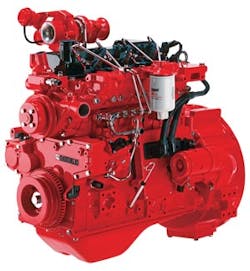Confused about all the changes for 2007 with diesel-powered ground support vehicles? You’re not alone. While most industries only deal with one EPA standard, airport personnel must understand two different standards, due to equipment such as catering trucks and refuelers, many of which use on-highway engines. Other types of purpose-built ground support equipment are powered by off-road diesels. The two types of engines are not required to meet the same emissions regulations and, as a result, don’t utilize the same technology.
The Rules Have Changed
For on-highway diesels, permissible emissions of Nitrogen Oxides (NOx) and Particulate Matter (PM) have been dramatically reduced. In order to meet stringent standards, these engines are now equipped with an after-treatment device known as a particulate filter. These filters, together with advanced combustion technology, reduce PM emissions by 90 percent, a significant improvement over pervious years.
The key to making them work well is removing sulfur from the fuel. That’s why Ultra-Low Sulfur Diesel (ULSD), with only 15 parts per million, has been mandated for on-road vehicle engines. ULSD is designed as backwards compatible, which means it can be used in pre-2007 on-highway engines as well.
The transition to low-sulfur diesel fuel (500 ppm) for non-road diesel engines took effect June 1 of this year, for fuel refineries and is required at retailers by October 2007. Many fuel refineries and distributors are switching to 100 percent production of ULSD (15 ppm) right now because they don’t want to incur the added expense and complexity of segregating the two different fuels.
Ground service maintenance professionals need to be aware and use the right fuel and the right oil in the right vehicles. low-sulfur diesel with 500-ppm should not be used in a 2007 on-road engine, since it can foul the particulate filter, cause premature loading, diminish performance and is not emissions compliant. Only 15-ppm USLD should be used in 2007 in on-road engines.
Putting USLD fuel into a Tier 3 or older off-road engine is allowed. Pumps are clearly identified with labels reading “ultra-low sulfur highway diesel fuel, low-sulfur highway diesel fuel and non-highway diesel fuel.”
Oils also changing
A new low-ash engine oil has been developed to keep engines running reliably and durably with minimal maintenance. The new oil, CJ-4, and it allows cleaning intervals of 200,000 to 400,000 miles (320,000 to 640,000 km) for particulate filters. CJ-4 is not recommended for use with low-sulfur diesel fuel (500 ppm), since it will reduce oil change intervals from previous years. It is a good idea to use CJ-4 oil in any on-road engine that is fueled with ULSD, regardless of whether it is a 2007 model or an earlier vintage.
To eliminate excess CI-4+ inventory, use it on engines that are running on ULSD. However, particulate filter cleaning intervals must be reduced. Cleaning is recommended at 150,000 to 350,000 miles (240,000 to 560,000 km) when using CI-4+ oil in a 2007 on-highway engine.
Adding Performance, Minimizing Maintenance
Engineers at Cummins tell us that performance of their 2007 on-highway engines is equal to or better than last year. Fuel efficiency is comparable to 2006 engines. Reliability and durability are unchanged. Maintenance takes place at the same intervals as before.
There are two new items which need servicing. The first is a coalescing filter in the crankcase ventilation system, which needs to be changed every fourth or fith oil change. The second is the particulate filter, which also needs to be cleaned. The exact interval will vary by application, duty cycle, oil consumption and the type of oil used. While the exact interval will vary by application, on average, users can expect their engines to go 150,000 to 400,000 miles (240,000 to 640,000 km) between particulate filter cleanings. The cleaning process itself takes only 90 to 120 minutes (including removal and re-installation).
Proven Technology
On-highway engines from most manufacturers use a combination of cooled Exhaust Gas Recirculation (EGR) and a particulate filter. ULSD fuel has been widely available since October 2006 for on-highway vehicles, and operators have experienced no significant problems to date.
Clearly Better
According to the Diesel Technology Forum Web site, “Last year’s trucks and buses produced one-eighth the amount of the tailpipe exhaust as they did in 1990. It would take 60 trucks built in 2007 to equal the soot emissions of one truck sold in 1988. The EPA predicts that these new clean diesel trucks—once they fully replace the existing fleet—will reduce emissions of smog-forming gases by 2.6 million tons each year and cut soot emissions by 110,000 tons annually.” Add the reduced emissions from off-road diesels, and the numbers become even more impressive. The switch to low-sulfur fuels should also reduce the amount of sulfur in the atmosphere and reduce the potential for acid rain.
While there may be some confusion about which fuel or oil to use, it’s clear that today’s clean diesels provide superior fuel economy, reliability and durability with dramatically reduced emissions. That’s good news for all ground vehicle operators, airport personnel and the communities we serve.





